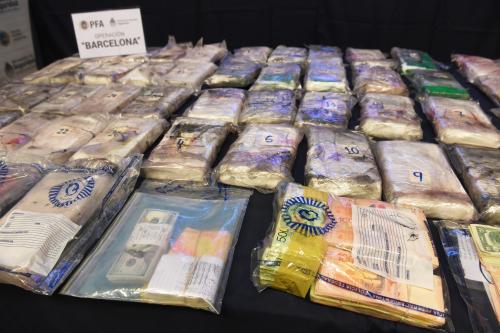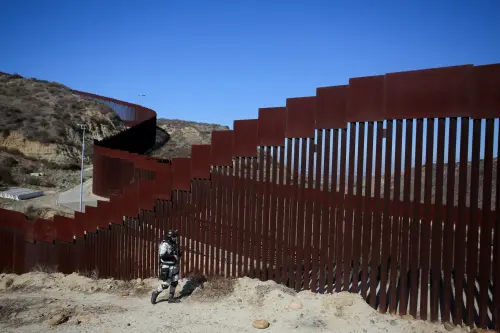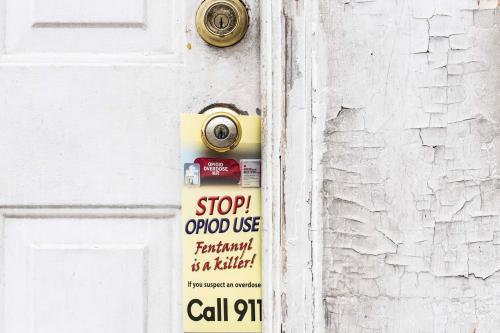Vanda Felbab-Brown discusses Mexican cartels’ presence in European drug markets – the production in Europe of highly potent cocaine – and some of the on-the-horizon questions and issues facing Europe and other markets which the Mexican Cartels could attempt to penetrate, such as the Middle East. This piece was originally published by Mexico Today.
The bipolar competition between the two largest Mexican cartels – the Sinaloa Cartel and Cartel Jalisco Nueva Generación – has spread around the globe. In this series, I have detailed the foreign policy choices and behavior of the Sinaloa Cartel and Cartel Jalisco Nueva Generación (CJNG) in Latin America, the Asia-Pacific region, Africa, and Europe and detailed the effects on local criminal markets and global drug trafficking trends of their arrival to these regions. In the last column, I explore how the Mexican cartels entered the European market through the cocaine trade and expanded Europe’s methamphetamine production for export to the Asia-Pacific region starting in about 2016. In this concluding column in my series on the foreign policies of the cartels, I discuss the third phase of the Mexican cartels’ presence in European drug markets – the production in Europe of highly potent cocaine – as well as some of the on-the-horizon questions and issues facing Europe and other markets which the Mexican Cartels could attempt to penetrate, such as the Middle East.
Despite the dynamism of the global meth markets and the daring decision of the Mexican cartels to attempt to cross the Chinese triads and supply meth into the Asia-Pacific from production based in the Netherlands and Belgium (as well as Mexico), the cocaine market in Europe did not remain static. Nor have the Mexican cartels stopped innovating in the European cocaine market.
Under the Mexican cartels’ supervision, more cocaine than ever appears to be flowing into Europe, with new European locations, such as Germany and France, rising as entry points for cocaine. In February 2021, German officials in Vlaardinger seized 18 tons of cocaine stashed in containers arriving from Paraguay, the largest ever seizure of cocaine in Europe even as ports such Antwerp saw cocaine seizures go up by a third. By 2020, the Mexican cartels have established European operations at least in the Netherlands, Belgium, Italy, Spain, Portugal, Germany, France, the United Kingdom, Ireland, Serbia, Albania, Romania, Slovakia as well as Morocco and Turkey.
With a kilogram of cocaine selling for US $60,000 in Western Europe, twice as much as in the United States, the focus of the Mexican cartels in not surprising. And the cartels seemed to have learned from the meth market that processing cocaine in Europe could generate even a more potent and thus more profitable drug. In the past five years, there has been a surprising emergence of the trafficking of coca base into Europe, where processing into cocaine has emerged in the Netherlands, Belgium, and Spain. Choosing to smuggle the bulkier, heavier, unfinished products, such as coca base, is harder and less efficient in terms of logistics and concealment of the product and normally less profitable. Around the world, the progression of drug markets is the opposite: toward processing drugs into finished products as close to the farmgate or the first lab as possible. So why the reverse with cocaine for Europe?
Because, it appears, that by using European processing facilities and high-quality precursors available in Europe, Mexican and Colombian cooks partnering up with European chemists have been able to produce some of the highest potency cocaine.
The three big questions that lie ahead for Europe and other regions are:
- How rapidly will the Mexican cartels or their European partners attempt to develop extensive meth consumption in Europe and in the Middle East?
- When will they start pushing synthetic opioids in Europe?
- Will the presence of the Mexican criminal groups in Europe and the new directions in illicit drug trends they spurred result in increases in criminal violence in European crime markets?
The answers to two of these questions already are a weak “now” and “yes.”
Though still relatively small, meth consumption is already expanding in Europe, beyond the long-established Czechia markets. In 2019, the value of the European market for amphetamines, meth, MDMA combined were estimated as at least US $1.6 billion, with some putting it much higher and estimating the global revenues of these synthetic drugs produced in the Netherlands in 2018 at US $20.6 billion. Since then, waste water analysis has identified increasing presence of methamphetamine residue in the Netherlands, Belgium, Germany, Cyprus, Denmark, Latvia, Lithuanian, Finland, and Norway. In the Netherlands, the street price of meth has fallen by 40 percent from 2019 to 2020. Whether this has been the inadvertent effect of the industrial production of BMK-based meth in Dutch and Belgian labs or purposeful decisions of either the Mexican cartels or their European crime partners to push meth in Europe, crystal meth use poses far more severe health harms than amphetamines and Ecstasy. In December 2020, the head of the Dutch Criminal Investigations Division, Andy Kraag, stated that “meth is a devastating drug, so it’s top priority for us to take down all those labs.” Certainly in Australia, a Mexican-cartels-Netherlands-Australia Ecstasy pipeline back in 2020 featured suppliers and pushers handing out free samples of crystal meth.
Moreover, the Mexican cartels can also try to push crystal meth to the Middle East. Even as affiliates of the Bashir al-Assad’s regime in Syria have emerged as top suppliers of “captagon” (a combination of amphetamine and caffeine) across the Middle East, Europe has continued to supplied amphetamine to the region, albeit at a decreasing rate. However, as I argued in my Chatham House article on captagon trends in the Middle East and the rising violence associated with new suppliers in the Middle East, the real drug watershed on the horizon for the Middle East is the spread of crystal meth use. Predominantly supplied from the vast Iranian meth production and to a lesser extent from a new, and less potent Afghanistan supply, it is already spreading in Iran and Iraq. The European and Mexican meth is a far superior product, and far more harmful, than the meth coming from Afghanistan. And unlike the ephedra and ephedrine-based production in Afghanistan, the BMK-based Mexican and European supply can be easily scaled to industrial levels.
Thus, the Mexican cartels can help tip the Middle East into an unprecedented drug crisis for which both law enforcement agencies in the Middle East and drug treatment systems are deeply unprepared and existing drug policies mostly unsuited.
Moreover, the Sinaloa Cartel already has connections with important Middle Eastern drug traffickers, such as Turkish drug groups and Lebanon’s Hezbollah. The relationship between the Sinaloa Cartel and Turkish crime gangs apparently began in the early 2010s, and today, the Sinaloa Cartel smuggles cocaine to and through Turkey, according to a former Turkish counternarcotics officer and criminology scholar Mahmut Cengiz.
Moreover, both the Sinaloa Cartel and the Lebanese militant group Hezbollah operate in drug markets in the Southern Cone, such as the Triborder Region of Brazil, Argentina, and Paraguay and in Venezuela where they collude with the Cartel of the Suns of the Venezuelan military.
A Hezbollah-Sinaloa Cartel (or eventually -CJNG) partnership could bring cocaine and meth to the Middle East at large volumes whether through or around the Assad regime, even though such a move would incur significant risks and costs for the Sinaloa Cartel, since it would put it in the crosshairs of U.S. counterterrorism, not just counternarcotics efforts.
An even more dangerous development than pushing large meth consumption would be a decision of the Mexican cartels to push synthetic opioids onto Europe. If the Taliban ever undertook the politically and economically-fraught and self-destructive decision to enforce its bans on opium, heroin, and meth production and trafficking (and the Taliban is far from any such enforcement), a heroin drought in Europe could provide a tempting opportunity. A rapid and resolute European law enforcement response to shut down fentanyl distribution and intensely punish fentanyl-distributing smuggling networks might have a chance to slow or even deter the move to synthetic opioids, as some Nordic countries managed about a decade ago. The odds are, however, fentanyl and other synthetic opioids will spread in Europe over time. After all, the Mexican cartels have many potential distributors to shop among across Europe and over time, through their presence in the growing meth retail markets in Europe, may even develop a larger retail presence. Like in the United States, they could start mixing fentanyl into cocaine and meth to hook European users.
And even if they get shut down in Europe, their headquarters and regeneration base in Mexico will remain thriving as long as Mexican governments do not find the wherewithal and greater effectiveness in countering their operations in Mexico.
How likely is the expansion of the cocaine and meth markets in and through Europe to trigger violence? In stark contrast to Latin America, European drug markets have been very peaceful, with overall homicides in Europe in the very low single digits per 100,000. Of course, Europe has had episodes of criminal violence flareups, perhaps most notoriously the mafia wars against the Italian state that in two decades, from the mid-1970s to the mid-1990s, killed prominent Italian prosecutors and some 3,000 people altogether (one year in Ciudad Juárez alone during the worst violence there a decade ago). Control over the expanding cocaine distribution opportunities in Ireland, the United Kingdom, and even Australia and New Zealand provoked a war between two Irish gangs that altogether led to some 15 homicides by 2019 in Ireland and Spain – one day of violence in Tijuana these days.
Other criminal violence flare-ups in Europe often entailed new criminal actors not yet socialized the power of European law enforcement, such as the expansion of Russian criminal groups in Eastern Europe and the Balkans in the 1990s; biker gang wars in Norway and Sweden in the 1990s that left about 50 people dead; the expansion of Pakistani gangs into drug trafficking in Denmark and the Nordics after 2010; and the rise of the Mocro Mafia (Dutch-Moroccan mafia) in the Netherlands after 2015 that included squads of teen hitmen, torture chambers, and even the assassination of a criminal lawyer and intimidation of witnesses.
In recent years, Europe has also seen the arrival of Colombian hitmen as well as those of North African origin, the latter supposedly charging between US 33,000 and 76,000 per hit in Spain, whereas the salary of a run-of-the mill sicario in Mexico has for a decade been as low as US $200, priests and NGO workers trying to help cartel members disengage from violence would tell me during my fieldwork in Mexico last year and a decade ago. Tragically, life and death in Mexico have become very cheap, the supply of potential hitmen abundant, and the frequency of hits civil-war-like intense.
In some cases, such as in the Italian one, violence died down because the Italian state lessened the prosecution efforts, or as in Eastern Europe, because the new criminal groups, the Russians, wrestled enough turf. In other cases, like the other aforementioned ones, the spikes is violence were turned off because European law enforcement agencies were able to come down with sufficient resoluteness and heft on the criminal groups on the violent actors, dismantle the groups and send key perpetrators to prison.
The odds are high that European law enforcement agencies will be able to maintain such incapacitation and deterrence capacities. Nor do the Mexican cartels in Europe have the firepower or manpower to bring to the Old Continent the violence they routinely unleash in Mexico. But the arrival of Colombian sicarios to Spain at least suggests the speculative possibility that under some circumstances the Mexican cartels could consider importing their hitmen to Europe to fight it with European criminal groups with greater history and easier resort to firearms and violence, such as Irish, Italian, Albanian, Russian, Serbian, Turkish, and Moroccan groups. Conversely, the Mexican cartels could attempt to mobilize these local proxies for violent takeovers of retail markets in Europe.
However, this has not been the modus operandi of the Mexican DTOs outside of Latin America. Fearing U.S. law enforcement, the Mexican cartels have not tried to violently reshape U.S. drug markets or create monopolistic supply-distribution relations in the United States like they have done across Latin America in recent years. In the United States, the Mexican cartels operate peacefully, albeit destructively. Specific U.S. retail markets, such as Chicago and Baltimore, remain highly violent for a wide set of reasons separate from the presence of the Mexican cartels.
The way criminal violence would more likely intensify in Europe is as a result of European criminal groups fighting among each other over lucrative and expanding retail markets of in cocaine, meth, and potentially synthetic opioid markets.
To some extent, this type of violence has already materialized in the Netherlands, Belgium, Spain, and France, though even with the temporary violence spikes, homicide and other violent rates even in those countries and in Europe overall still remain in the single digits per 100,000 and a tiny fraction of criminal violence in Latin America.
In exploring the foreign policies of the Sinaloa Cartel and CJNG, I left their European and Middle Eastern operations for last because their changing presence in Europe and the possibilities it opens for going to the Middle East brings together the moves and choices they made and operations they built up in Latin America from the Southern Cone to Central America, in West Africa, as well in Asia and the Pacific. And in an uncanny parallel with the new global geopolitics of Great Power Competition among governments, the foreign policy decisions of the Mexican cartels in Asia drove some of their policy choices in Europe.
The Brookings Institution is committed to quality, independence, and impact.
We are supported by a diverse array of funders. In line with our values and policies, each Brookings publication represents the sole views of its author(s).







Commentary
Op-edThe foreign policies of the Sinaloa Cartel and CJNG – Part V: Europe’s supercoke and on-the-horizon issues and the Middle East
September 16, 2022